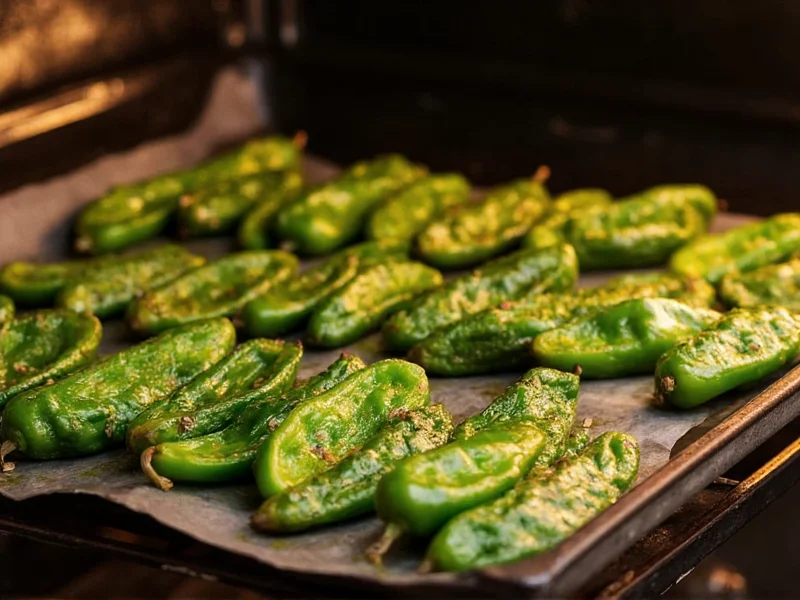Drying jalapeño peppers in your oven transforms fresh chilies into versatile, shelf-stable ingredients perfect for cooking, seasoning, and preserving summer's harvest. This method offers greater control than air drying while being more accessible than specialized dehydrators. Understanding the proper technique ensures you maintain maximum flavor, heat, and nutritional value while preventing spoilage.
Why Oven-Dry Jalapeños?
Oven drying provides several advantages over alternative preservation methods. Unlike canning, which alters flavor through vinegar and heat processing, oven drying concentrates the natural capsaicin and complex flavors of jalapeños. Compared to air drying, the controlled oven environment significantly reduces drying time and minimizes contamination risks from dust or insects. For home cooks without dehydrators, your conventional oven delivers reliable results with minimal equipment.
Preparing Jalapeños for Drying
Select firm, blemish-free jalapeños at peak ripeness. Green peppers offer traditional heat, while red-ripe jalapeños provide sweeter, more complex flavor. Wash thoroughly under cold water and pat completely dry with clean towels. Wear gloves during preparation to prevent capsaicin burns on sensitive skin.
Slice peppers lengthwise to maximize surface area while maintaining structural integrity. Remove seeds and white membranes if you prefer milder dried peppers, though retaining some membranes preserves maximum heat. For how to dry whole jalapeño peppers in oven, pierce skins in several places to facilitate moisture escape, though sliced peppers dry more evenly.
Optimal Oven Drying Technique
The best temperature to dry jalapeños in oven ranges between 140-170°F (60-75°C). Higher temperatures risk cooking rather than drying, destroying volatile flavor compounds and causing uneven results. Most home ovens don't accurately maintain temperatures below 170°F, so use an oven thermometer for precision.
Arrange prepared peppers in a single layer on wire racks placed over baking sheets. This setup promotes air circulation around all surfaces. Leave your oven door slightly ajar (2-3 inches) using a wooden spoon to maintain consistent airflow and prevent moisture buildup. Rotate trays periodically for even drying.
| Drying Method | Temperature | Time Required | Flavor Preservation |
|---|---|---|---|
| Oven Drying | 140-170°F | 6-12 hours | Excellent |
| Food Dehydrator | 135-150°F | 8-12 hours | Superior |
| Air Drying | Ambient | 1-3 weeks | Good |
| Freeze Drying | Subzero | 24-48 hours | Exceptional |
Monitoring Drying Progress
Check peppers every 2-3 hours after the first 4 hours. Properly dried jalapeños become brittle and snap cleanly when bent. Flexible or leathery peppers require additional drying time. The how long to dry jalapeños in oven depends on pepper thickness, moisture content, and oven consistency—typically 6-12 hours for sliced peppers.
Never rush the process with higher temperatures. Excessive heat causes case hardening—where the exterior dries too quickly, trapping moisture inside that leads to mold during storage. If your kitchen remains humid, extend drying time by 25-50% to ensure complete moisture removal.
Storing Oven-Dried Jalapeños
Before storage, condition peppers by placing them in an airtight container for 7-10 days, shaking daily. This equalizes any residual moisture. For oven dried jalapeño storage, use vacuum-sealed bags or glass jars with oxygen absorbers in a cool, dark pantry. Properly dried and stored jalapeños maintain quality for 12-18 months.
Check stored peppers monthly for moisture condensation or mold. If detected, return affected peppers to the oven for additional drying. Never store dried peppers near heat sources or in direct sunlight, which degrades capsaicin and flavor compounds.
Creative Uses for Dried Jalapeños
Dried jalapeños offer culinary versatility beyond fresh peppers. Rehydrate in hot water for 20 minutes to use in sauces, stews, or salsas. Grind into flakes for seasoning meats, vegetables, or popcorn. Create homemade japones (dried jalapeño powder) by processing completely dry peppers in a spice grinder.
Infuse dried jalapeños in olive oil for spicy cooking oil, or steep in vinegar for artisanal hot sauce. Add whole dried peppers to soups and stews for gradual heat infusion, removing before serving. For authentic Mexican cuisine, rehydrated dried jalapeños form the base of salsa roja and adobo sauce.
Troubleshooting Common Issues
Peppers turning brown: Oven temperature too high. Reduce heat and extend drying time. Mold development: Incomplete drying or improper storage. Return to oven immediately. Uneven drying: Rotate trays more frequently and ensure consistent spacing.
If you're wondering why dry jalapeños in oven instead of dehydrator, remember that ovens provide sufficient results for occasional use without specialized equipment investment. However, dehydrators offer more consistent temperatures and better airflow for frequent drying needs.
Safety Considerations
Always wear gloves when handling hot peppers, especially during preparation. Work in well-ventilated areas to avoid capsaicin fumes irritating your eyes and respiratory system. Never touch your face during processing. Clean all surfaces and tools thoroughly with soapy water after handling to prevent accidental exposure later.











 浙公网安备
33010002000092号
浙公网安备
33010002000092号 浙B2-20120091-4
浙B2-20120091-4